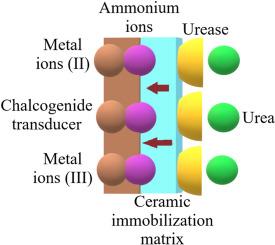以沸石和氧化镓半导体薄膜为活性材料的尿素生物传感器:综述。
IF 2.6
4区 生物学
Q2 BIOCHEMICAL RESEARCH METHODS
引用次数: 0
摘要
近年来,通过测量尿素水平来诊断肾功能衰竭一直是一个热门研究课题。研究的重点是提高尿素生物传感器的灵敏度、线性度、精确度、准确性和选择性。虽然尿素生物传感器的制造中使用了多种材料,但陶瓷和钙化物在这一领域的应用较少。最近,人们研究了陶瓷(如沸石)的使用,以改进尿素生物传感器中的酶固定方法及其在离子选择膜中的应用,从而提高设备的特异性。虽然氧化物已被广泛用作尿素生物传感器中的传感器,但元素周期表第 VI 族的铬化半导体材料也显示出良好的性能,如化学稳定性、信号传导能力和改进的电学测量。本综述全面概述了尿素生物传感器的最新研究成果,特别强调了使用陶瓷固定酶和铬化物作为换能器的情况,以及这些材料如何有助于提高这些设备的性能。本文章由计算机程序翻译,如有差异,请以英文原文为准。

Urea biosensors based in zeolites and chalcogenide-oxide semiconductor thin films as active materials: A review
Diagnosis of renal failure by measuring urea levels has been a topic of intense study in recent years. A major focus has been on improving the sensitivity, linearity, precision, accuracy, and selectivity of biosensors for measuring urea. Although various materials have been used in the fabrication of urea biosensors, ceramics, and chalcogenides have been less explored in this field. Recently, the use of ceramics such as zeolite has been investigated to improve enzyme immobilization methods in urea biosensors and their application in ion-selective membranes, to increase the specificity of the devices. While oxides have been widely used as transducers in urea biosensors, chalcogenide semiconductor materials from Group VI of the periodic table also show promising properties, such as chemical stability, to signal transduction capability, and improved electrical measurements. This review provides a comprehensive overview of recent research in urea biosensors, with a special emphasis on the use of ceramics for enzyme immobilization and chalcogenides as transducers and how these materials contribute to improving the performance of these devices.
求助全文
通过发布文献求助,成功后即可免费获取论文全文。
去求助
来源期刊

Analytical biochemistry
生物-分析化学
CiteScore
5.70
自引率
0.00%
发文量
283
审稿时长
44 days
期刊介绍:
The journal''s title Analytical Biochemistry: Methods in the Biological Sciences declares its broad scope: methods for the basic biological sciences that include biochemistry, molecular genetics, cell biology, proteomics, immunology, bioinformatics and wherever the frontiers of research take the field.
The emphasis is on methods from the strictly analytical to the more preparative that would include novel approaches to protein purification as well as improvements in cell and organ culture. The actual techniques are equally inclusive ranging from aptamers to zymology.
The journal has been particularly active in:
-Analytical techniques for biological molecules-
Aptamer selection and utilization-
Biosensors-
Chromatography-
Cloning, sequencing and mutagenesis-
Electrochemical methods-
Electrophoresis-
Enzyme characterization methods-
Immunological approaches-
Mass spectrometry of proteins and nucleic acids-
Metabolomics-
Nano level techniques-
Optical spectroscopy in all its forms.
The journal is reluctant to include most drug and strictly clinical studies as there are more suitable publication platforms for these types of papers.
 求助内容:
求助内容: 应助结果提醒方式:
应助结果提醒方式:


